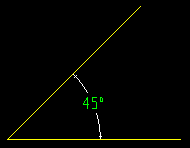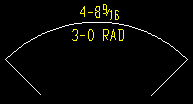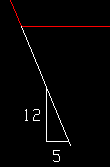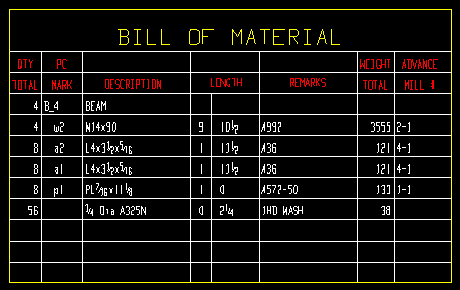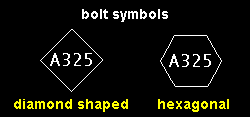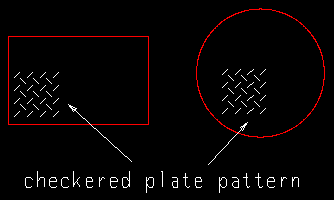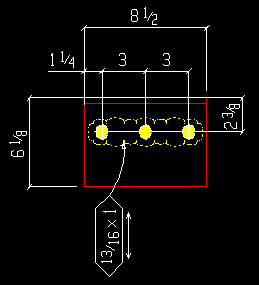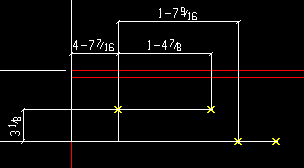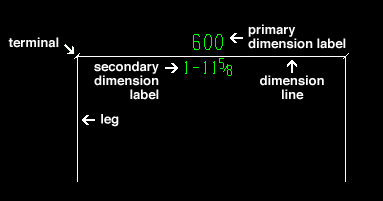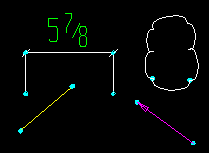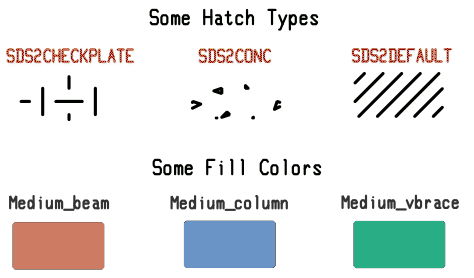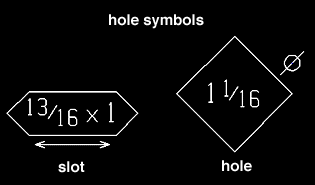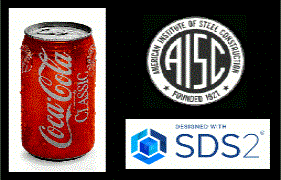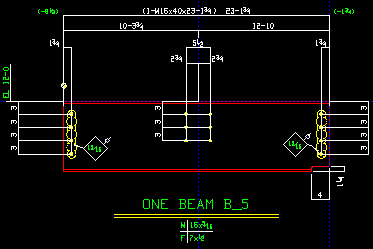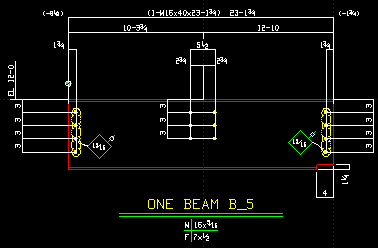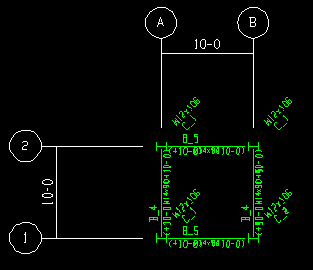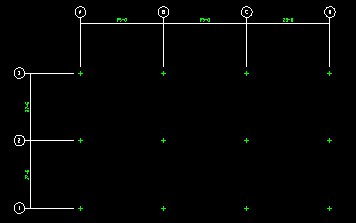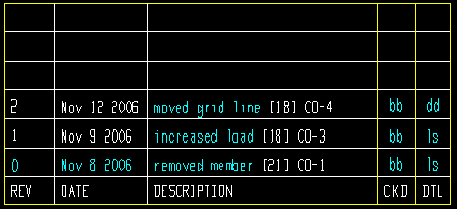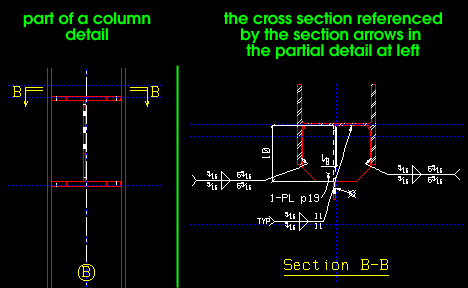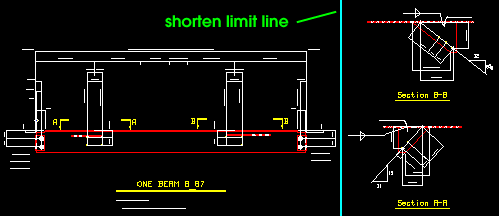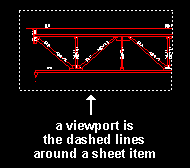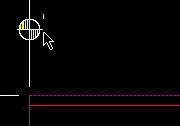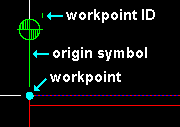Drawing Editor Objects
page 1 | contents | topics | graphics, objects & decorations
Angle dimensions can be added or edited on non-comment layers only when your current Drawing Editor drawing is a crane placement drawing . On all other drawings, adding and editing of graphic objects is limited to comment layers. These instructions assume that your current drawing is not a crane placement drawing.
|
An angle dimension measures the angle between two lines, two polygon lines or a line and a polygon line. The lines cannot be parallel, but they do not have to touch one another. The measured angle can be expressed in radians or degrees. |
Angle dimension tools: Angle Dimension Add can add an angle dimension to a comment layer . Angle Dimensions Edit can review angle dimensions on non-comment layers, or edit angle dimensions on comment layers. Angle Dimension Edit All can be used to edit all angle dimensions that are on shown comment layers. Angle Dimension Erase can delete selected angle dimensions that are on comment layers. Angle Dimension Erase All deletes all angle dimensions that are on shown comment layers. The display of " Dimensions " (including angle dimensions) can be turned on/off on the Display Options window. Angle dimension settings can be found on the Edit Angle Dimension window.
Moving an angle dimension or its parts: You can Shift -drag an angle dimension label that is on a comment layer to a new position. You can drag an angle dimension label that is on a comment layer to rotate it, thus updating the " Rotation (degrees) " field. On a comment layer, you can drag an angle dimension line (the line with arrows) to expand or contract its arc length while keeping its label the same. On a comment layer, you can drag an angle dimension line (the line with arrows) to a new quadrant and thus cause the angle dimension to be recalculated.
Printing of angle dimensions: The drawing pen number applied during auto detailing of dimension labels is the " Dimension label pen color " set in Drawing Presentation . During printing, the pen number of the dimension label sets the plotted stroke weight of the text if you are using the SDS2 font. " Dimension pen color " sets the pen number that is applied to dimension lines and legs during auto detailing, and this pen number in turn sets the plotted line thickness of dimension lines and legs. To change the line color and line thickness assigned to a pen number for plotting and printing, see Line Weights .
Setup: Drawing Presentation (primary dimensions only). " Display measurement unit for angle dimensions " in the " General " tab of Dimension Settings sets the default units to be ' Degrees ' or ' Radians '. The " Angle dimension precision " sets the number of places after the decimal point that the calculated angle dimension is rounded to. The primary default character " Height " and " Width " may be set on the Edit Palette prior to an Dimension Add Angle operation.
page 1 | contents | topics | graphics, objects & decorations | top
Arcs are partial circles or partial ellipses. Arcs can be added or edited on non-comment layers only when your current Drawing Editor drawing is a crane placement drawing . On all other drawings, adding and editing of graphic objects is limited to comment layers. These instructions assume that your current drawing is not a crane placement drawing.
|
Arc add tools: Arc Add (the legacy tool), Arc Add Center, Start, End , Arc Add Center, Start, Angle , Arc Add Continuous , Arc Add 3 Point , Arc Add Ellipse (
). The Arc Edit window opens for arcs added using these tools when User and Site Options > Drawings > "
: Always show Arc Edit window " is on (checked). Except on crane placement drawings, these tools can add an arc to a comment layer , but not to a non-comment layer.
Other arc tools: Arc Edit can review arcs on non-comment layers, or Arc Edits on comment layers. Arc Edit All can be used to edit all arcs that are on shown comment layers. Arc Erase can delete selected arcs that are on comment layers. Arc Erase All deletes all arcs that are on shown comment layers. Shield and Trim (
) can remove a segment of an arc. Extend can extend an arc. Performing Shield and Trim on a circle turn that circle into an arc.
Also: Arc settings are shown on the Arc Edit window. You can turn on/off the display of arcs using " Arcs " on the Display Options window. To move an arc, drag it in Select Items mode. INCR snaps to the intersection of a constrution line or construction circle with an arc.
Setup for adding arcs: The default display color (pen number) and line type (dash pattern) of the first arc added using Add Arc is set using the Edit Palette . The last-added or last-edited arc sets the defaults for subsequently added arcs unless you change the Edit Palette in the meantime.
page 1 | contents | topics | graphics, objects & decorations | top
Arc dimensions can be added or edited on non-comment layers only when your current Drawing Editor drawing is a crane placement drawing . On all other drawings, adding and editing of graphic objects is limited to comment layers. These instructions assume that your current drawing is not a crane placement drawing.
|
In this example, the arc dimension shows both the "arc distance" (primary) and the "on radius" dimension (secondary). |
What it does: An arc dimension measures the length of the arc between two points on a circle. This program cannot generate elliptical arc dimensions -- arc dimensions are always circular.
Arc dimension tools: Dimension Add Arc can add an arc dimension to a comment layer but not to a non-comment layer. Arc Dimension Edit can review arc dimensions on non-comment layers, or Edit Arc Dimensions on comment layers. Arc Dimension Edit All can be used to edit all arc dimensions that are on shown comment layers. Arc Dimension Erase can delete selected arc dimensions that are on comment layers. Arc Dimension Erase All deletes all arc dimensions that are on shown comment layers.
Also: Settings for dimensions are shown on the Edit Arc Dimension window or on the " Arc Dimensions " tab of the Multi Items Edit window. You can base arc dimensions off of a circular object such as a construction circle or circle or arc or another arc dimension . You can add a chain of arc dimensions by locating points . The " Dimensions " option on the Display Options window can be used to turn on/off the display of arc dimensions as well as dimensions. You can edit multiple arc dimensions and " Save " and " Load " archived files of arc dimension settings.
Moving and stretching arc dimensions: This is done in roughly the same way that you move/stretch parts of dimensions in Select Items mode. Hold down the Shift key to move a dimension label. Movement of the leg of an arc dimension is constrained around the radius of the imaginary circle that the arc dimension measures points on -- this means that the distance shown on the dimension label changes, but the " on radius " dimension always remains the same.
Printing of arc dimensions: The drawing pen number applied (in a full-featured SDS2 program) during automatic detailing of dimension labels is the " Dimension label pen color " set in Drawing Presentation . During printing, the pen number of the dimension label sets the plotted stroke weight of the text if you are using the ' SDS2 ' font . " Dimension pen color " sets the pen number that is applied to dimension lines and legs during auto detailing, and this pen number in turn sets the plotted line thickness of dimension lines and legs. To change the line color and line thickness assigned to a pen number for plotting and printing, see Line Weights .
Setup: Drawing Presentation (primary and secondary dimensions). " Show "on radius" dimension for arc dimensions " is an option on the Dimension Settings setup window. The primary and secondary default character " Height " and " Width " may be set on the Edit Palette prior to an Dimension Add Arc operation.
page 1 | contents | topics | graphics, objects & decorations | top
| An area box drawn from left to right. |
|
An area box drawn from right to left. |
To draw an area box: Hold down the left mouse button in Select Items mode and drag your mouse pointer (
) diagonally across the screen. Items within the periphery of the area box will be selected or deselected depending on whether you have no key pressed ( Select ) or the Shift key pressed ( Select + ) or the Ctrl key pressed ( Select- ) or the Shift + Ctrl keys pressed ( Toggle ).
Direction matters: If User and Site Options > General > " Point selection by area box " is set to ' Directional ', then the direction you draw the area box (left to right versus right to left) controls whether or not the entirety of an object needs to be inside the area box for it to be selected.
An area box can select or deselect: An area box drawn using Select or Select + can only be used to select items. An area box drawn using Select- can only deselect items that are already selected. An area box drawn using Toggle inverts the selection state of items so that previously selected items are deselected and previously unselected items are selected.
Selectivity varies: An area box can be used to select multiple lines, circles, end points or labels as a group. Set one or multiple selection filters to limit the type of objects you want to select within the area box (lines and/or circles and/or labels, etc.).
Also see: Lasso selection
page 1 | contents | topics | graphics, objects & decorations | top
Bevel symbols can be added or edited on non-comment layers only when your current Drawing Editor drawing is a crane placement drawing . On all other drawings, adding and editing of graphic objects is limited to comment layers. These instructions assume that your current drawing is not a crane placement drawing.
|
This bevel symbol shows the bevel of the edge of a plate. Bevel symbols can optionally be made to report the angle in degrees. |
Bevel symbol tools: Bevel Symbol Add can add a bevel symbol to a comment layer but not to a non-comment layer. Bevel Symbol Edit can review bevel symbols on non-comment layers, or edit bevel symbols on comment layers. Bevel Symbol Erase can delete selected bevel symbols that are on comment layers. Bevel Symbol Erase All deletes all bevel symbols that are on shown comment layers.
Also: Settings for bevel symbols are shown on the Bevel Symbol window. In Select Items mode, grab a bevel symbol's tail to move the bevel symbol; grab the bevel's triangle to stretch the symbol or flip it. There is also a " Flip symbol " option on the Bevel Symbol window.
Display Options: " Bevel symbols "
Setup: A bevel symbol's " Rise " or " Run " is based on the Home > Project Settings > Fabricator > Detailing Symbol Settings > " Bevel symbol base dimension ."The default drawing pen number applied to a bevel symbol during auto detailing is set in Line Weights and in Drawing Presentation using the option " Bevel pen color ." During printing, the pen number sets the line thickness of the bevel symbol. If you are using the ' SDS2 ' font , the pen number also sets the stroke weight of the printed text.
page 1 | contents | topics | graphics, objects & decorations | top
A bill of material is likely to be found on a sheet outline or on detail sheets and may be found on other types of drawing. You cannot place a bill of material in Site Planning, but you can review bills of material that have been placed there by a full-featured SDS2 program .
|
|||
| The bill data in this example is the text that is displayed in the color white. That text comes from information associated with a member detail ( B_4 ) which was placed onto the sheet. |
Data in a member bill of material is compiled from the individual member details that are placed on a detail sheet. You can review that data in the Bill of Material Editor , which is found in the Drawing Editor . For the example above, you would have to open the member deail named B_4 to see the data shown here.
The column heads that appear on a bill of material, at least when it is first placed, depend on the choices made to the Job Options option Bill of Material Layout .
Data compilation into a placed bill :
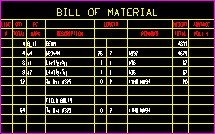
Bill data in this example is the text that is displayed in the color white. Data compilation is the means by which the bill data is entered to a bill of material.
Drawing Type Data Compilation all drawing types except submaterial Users of a full-featured SDS2 program can manually type data into the bill editor . When a bill is placed onto a drawing, data entered into the bill editor will also be entered to the placed bill.
member details A member detail automatically has bill data compiled into its bill editor when that member is auto detailed . If a bill is placed onto a member detail or detail sheet with member details on it, the bill data from auto detailing will be compiled into the placed bill. Data can also be compiled into a member detail's bill of material using Add Standard Detail , Add Bolt , Material Drafting .
sheet outlines Data typed to the bill editor will be placed at the top of the placed bill. If the sheet outline is used for a detail sheet , additional bill data will be compiled into the bill of that sheet when member details are added in a full-featured SDS2 program . global or job standard details The bill editor can be used in a full-featured SDS2 program to edit the bill of material associated with a standard detail. When you Add Standard Detail to a detail sheet with a bill of material on it, you can optionally " Add to bill of material (on Locate) ." detail sheet A bill can be placed directly onto the sheet or onto its sheet outline (before the sheet is created using that sheet outline). Data typed to the bill editor of the detail sheet will be at the top of the placed bill. Additional bill data will compile into the bill when member details are added in a full-featured SDS2 program or when you Add Standard Detail with " Add to bill of material (on Locate) ."
page 1 | contents | topics | graphics, objects & decorations | top
Bolts can be added or edited on non-comment layers only when your current Drawing Editor drawing is a crane placement drawing . On all other drawings, adding and editing of graphic objects is limited to comment layers. These instructions assume that your current drawing is not a crane placement drawing.
|
User-added and auto-detailed bolts can be modified using the same tools. |
User-added versus auto-detailed bolts: User-added bolts are bolts added using Add Bolt in the Drawing Editor . Auto-detailed bolts are generated (in a full-featured SDS2 program , not in an SDS2 review station ) during auto detailing of members or erection views. Only shop bolts are auto detailed on member details -- field bolts may be listed on the member's bill of material, but they are not drawn on the detail.
Tools for user-added and auto-detailed bolts: The display of '' Bolts " can be turned on/off on the Display Options window. The ' Bolts ' selection filter applies to all bolts, regardless of how they were generated. Bolt settings are shown on the Bolt Edit window or on the " Bolts " tab of the Multi Items Edit window. Bolt Edit can review bolts on non-comment layers, or edit user-added bolts on comment layers. On a crane placement drawing, Bolt Edit can edit bolts on both comment layers and non comment layers.
Tools for user-added bolts on comment layers: Bolts Add can add a bolt to a comment layer , but not to a non-comment layer. Delete , Bolt Erase and Bolt Erase All can delete bolts that have been added to comment layers. You can edit multiple bolts that have been added to comment layers and " Save " and " Load " archived files of settings. You can move bolts on comment layers by dragging them in Select Items mode, or by using Move/Stretch . You can Explode bolts on comment layers into component lines, including lines with dash patterns.
Tools for auto-detailed bolts: To review the 3D settings (from the 3D model) of an auto-detailed bolt, you can use Review 2D Items , or you can double-click the bolt with the selection filter set to ' Polygons ' -- either method will open a non-editable version of Modeling's Bolt Edit window.
page 1 | contents | topics | graphics, objects & decorations | top
Bolt symbols can be added or edited on non-comment layers only when your current Drawing Editor drawing is a crane placement drawing . On all other drawings, adding and editing of graphic objects is limited to comment layers. These instructions assume that your current drawing is not a crane placement drawing.
|
Bolt symbol tools: Bolt Sym Add can add a bolt symbol to a comment layer , but not to a non-comment layer. Bolt Sym Combo adds a bolt symbol in combination with optional pointers and leader lines to a comment layer. Bolt Sym Edit can review bolt symbols on non-comment layers, or edit bolt symbols on comment layers. Bolt Sym Erase can delete selected bolt symbols that are on comment layers. Bolt Sym Erase All deletes all bolt symbols that are on shown comment layers.
Also: Bolt symbol settings are on the Bolt Symbol Input window. You can drag a bolt symbol that is on a comment layer. You can use Copy Objects to copy a bolt symbol. A bolt symbol has one exact point . The symbol has a " Symbol location " option which controls its position with respect to its exact point (' Left " or " Right " or " Top " or " Bottom ").
Setup for auto-detailed bolt symbols: Setup for auto detailing bolt symbols for callouts of non-standard field bolts is found on the Nonstandard Field Bolts on Erection View Details window in Fabricator Setup .
page 1 | contents | topics | graphics, objects & decorations | top
A checkered plate pattern is drawn on plate materials during automatic detailing in a full-featured SDS2 program when the box is checked for " Checkered " on the material edit window for a bent plate or multi-bend plate or multi-sided flat plate or rectangular plate or rolled plate or round plate . The pattern is shown as a small sample on the plate. Checkered plate patterns cannot be generated in Site Planning.
|
page 1 | contents | topics | graphics, objects & decorations | top
Circles and ellipses . In versions of SDS2 software prior to v2018, ellipses were circles that had been rotated. Now ellipses and circles have different edit windows and different add tools: Ellipses and circles, however, are not ditinct object types. When they are multi-ediited together, the Ellipse Setup window opens.
|
Three perfect circles. |
Add tools for circles and ellipses let you -- for drawing types other than crane placement drawings -- add a circle or ellipse to a comment layer but not to a non-comment layer. Edit tools can review -- for most drawing types -- circles or ellipses on non-comment layers, or edit objects on comment layers. Only on a crane placement drawing can users add or edit objects that are on non-comment layers.
Circle add tools: Circle Add Radius (
), Add Diameter , Add 2 Point , Add Tan Tan Radius (
). The Circle Setup window opens for circles added using these tools when User and Site Options > Drawings > "
: Always show Circle Edit window " is on (checked).
Ellipses add tools: Ellipse Add Center (
), Ellipse Add Axis End (
). The Ellipse Setup window opens for ellipses added using these tools when User and Site Options > Drawings > "
: Always show Circle Edit window " is on (checked).
An add tool for circles and ellipses: Circle Offset .
Tools common to circles and ellipses: Circle Edit lets you edit the circles that you select. Circle Edit All edits all circles that are on shown comment layers. Circle Erase deletes the circles that you select. Circle Erase All deletes all circles that are on shown comment layers. Shield and Trim (
) can remove a segment of a circle and thus turn that circle into an arc.
Also: Settings for circles can be found on the Circle Setup window or on the " Circles " tab of the Multi Items Edit window or on the Ellipse Setup window. The Edit Palette sets the default dash pattern & color for add operations The display of " Circles " (and ellipses) can be turned on/off on the Display Options window. A circle or ellipse has one exact point . To move a circle or ellipse, drag it in Select Items mode. You can edit multiple circles and " Save " and " Load " archived files of circle settings. INCR snaps to the intersection of a construction line or construction circle with a circle.
page 1 | contents | topics | graphics, objects & decorations | top
Clouds are used to enclose a group of items on a detail so that in informative annotation can call out a feature that is common to all items in the group. Clouds can be added or edited on non-comment layers only when your current Drawing Editor drawing is a crane placement drawing . On all other drawings, adding and editing of graphic objects is limited to comment layers. These instructions assume that your current drawing is not a crane placement drawing.
|
Part of a system-generated submaterial detail. The cloud (drawn in yellow) groups the three holes together so that all three holes can be identified as 13/16 x 1 slots. |
Cloud tools: Cloud Add can add a cloud to a comment layer , but not to a non-comment layer. Cloud Edit can review clouds on non-comment layers, or edit clouds on comment layers. Cloud Edit All can be used to edit all clouds that are on shown comment layers. Cloud Erase can delete selected clouds that are on comment layers. Cloud Erase All deletes all clouds that are on shown comment layers.
Also: The " Clouds " option on the Display Options window can be used to turn on/off the display of clouds. To move a cloud, drag it in Select Items mode. You can stretch a cloud by grabbing its end points using Move/Stretch .
Setup for clouds: " Cloud pen color " sets the pen for auto detailed clouds. The last-added or last-edited cloud sets the default pen (plotted line thickness) and line type (dash pattern) for clouds added using Cloud Add . The pen and line type can also be set using the Edit Palette .
Also note: During Detail Members in a full-featured SDS2 program , the program may cloud changes in the drawing.
page 1 | contents | topics | graphics, objects & decorations | top
CNC marks are holes with zero diameter which, when applied by a punch or drill, become shallow divots on the surface of a material. These are represented on Drawing Editor details by an X.
|
CNC marks are dimensioned on submaterial details such as this one |
Purpose of CNC marks: CNC marks on shop materials may be used as reference points for fastening submaterials to a member's main material, or they might serve as guide points or identification marks for erection purposes.
Computer numerical control: The SDS2 CNC Module has the capability of automatically downloading the position of CNC marks (as well as holes, copes, etc.) to CNC machines.
Setup: CNC marks can be generated automatically per Home > Project Settings > Fabricator > Detailing > CNC Center Marks .
Warning: CNC marks (and holes) added in the Drawing Editor cannot be downloaded to CNC machines.
page 1 | contents | topics | graphics, objects & decorations | top
Construction lines/circles are dashed lines, circles or ellipses that appear in both the Drawing Editor and Modeling . Construction lines and circles can be added or edited on non-comment layers only when your current Drawing Editor drawing is a crane placement drawing . On all other drawings, adding and editing of graphic objects is limited to comment layers. These instructions assume that your current drawing is not a crane placement drawing.
|
These construction circles are perfect circles. Construction circles can also be ellipses. |
Purpose of: Construction lines and circles are used with Locate options for placing objects in a drawing. They may also be used for measuring distances using the Ruler .
Special characteristics: Unlike other graphic symbols that may appear on drawings in the Drawing Editor , construction lines/circles are not Plotted .
Construction line tools: Construction Line Add can add a construction line to a comment layer , but not to a non-comment layer. Construction Line Edit can review construction lines on non-comment layers, or edit construction lines on comment layers. Construction Lines Edit All can be used to edit all construction lines that are on shown comment layers. Construction Line Erase can delete selected construction lines that are on comment layers. Construction Line Erase All deletes all construction lines that are on shown comment layers. The " Construction lines " option on the Display Options window can be used to turn on/off the display of construction lines.
Construction circle add tools: Construction Circle Add Radius and Construction Circle Add Diameter and Construction Circle Add 2 Point and Construction CircleTan Tan Radius and Construction Circle Ellipse Add Center and Construction Circle Ellipse Add Axis End are add tools for construction circles. The Construction Circle Edit window opens for circles added using these tools when User and Site Options > Drawings > "
: Always show Circle Edit window " is on (checked). Except on crane placement drawings, these tools can add a construction circle to a comment layer , but not to a non-comment layer.
Other construction circle tools: Construction Circle Edit can review construction circles on non-comment layers, or edit construction circles on comment layers. Construction Circle Edit All can be used to edit all construction circles that are on shown comment layers. Construction Circle Erase can delete selected construction circles that are on comment layers. Construction Circles Erase All deletes all construction circles that are on shown comment layers. The " Construction circles " option on the Display Options window can be used to turn on/off the display of construction circles.
Selection: To select (or edit with a double-click) construction lines or construction circles in Select Items mode, the selection filter must be set to ' Con Lines ' or ' Con Circles ' or '' Material Construction Lines ' or ' All '. You can select construction line or circle end points (for moving) when the selection filter is ' End points '. Click here for instructions on how to select construction lines by area (in Select Items mode).
Moving: Click here for instructions ( Drawing Editor only) on how to move a construction line or construction circle in Select Items mode. Since construction lines and construction circles have end points , you can also move them by grabbing their end points.
Setup: User and Site Options > General > " Default color " and " Allow multicolored construction lines ."
page 1 | contents | topics | graphics, objects & decorations | top
Detail view drawings are drawing files that were originally created in Site Planning or in a full-featured SDS2 program. In a full-featured SDS2 pgram, the drawings can be created from member details , erection view drawings or submaterial details . In Site Planning, Detail View Add can be done in a crane placement drawing . The detail view drawing file can be edited independently of the crane placement drawing that it was created in.
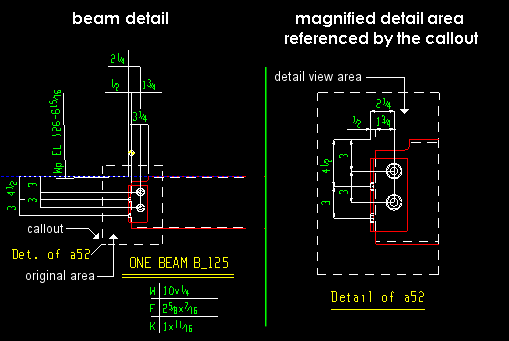
|
| A detail view is a original area/detail view area pair that can be placed on a member detail, erection view drawing or submaterial detail. In Site Planning, Detail View Add can be peformed in a crane placement drawing . |
|
If you Open Detail View Drawing while in a drawing in the Drawing Editor , you will be able to select a detail view drawing (if one exists). |
To manually create a detail view drawing: You can Detail View Add in a crane placement drawing . The results of your adding the detail view will be seen immediately in the parent drawing (e.g., the erection view), but you will need to open the detail view drawing to make modifications to that detail view.
To open a detail view drawing while in the parent drawing: Open Detail View Drawing . Alternatively, you can double-click the detail view on the original creating parent drawing to open the Detail View Area window. Then, on that window press the " Open " button.
To open a detail view drawing from any Drawing Editor drawing: Open Drawing ( Ctrl + o ) > select the parent drawing type (
Details or
Submaterial or
Erection views) > check the box for "
Detail Views " > double-click the detail vew file name. A similar procedure can also be accomplished from Home > Launch Drawing Editor .
To delete detail view drawings: Open the original creating parent drawing the detail view is placed in. Select the detail view and press the Delete key. This removes the detail view drawing as well as the original view area and detail view area on the parent drawing. Deleting also removes the detail view drawing from all drawings or sheets that it has been added to as a sheet item.
To add a detail view drawing as a standard detail: Add Standard Detail or Add Standard Detail to Several . The detail view is added to the drawing as lines, labels and dimensions, which can individually be modified or deleted. Only detail view drawings whose creating drawing is a submaterial can be added in this way.
To add a detail view drawing as a sheet item: Sheet Item Add . The sheet item is linked to detail view drawing. You can modify the sheet item using Open Drawing ( Ctrl + o ) and changing the original detail view file. The types of drawings that a detail view drawing can be added to as a sheet item depends on the drawing type of the creating drawing .
A detail view drawing can be added as a sheet item IF its creating drawing is one of these drawing types: submaterial detail member detail, 2D erection view, sheet outline or detail/erection/gather sheet. member detail
(including " Sub-Members ")sheet outline or detail/erection/gather sheet. 2D erection view sheet outline or 2D erection view or detail/erection/gather sheet. A 2D erection view cannot be added as a sheet item to itself. Sheet items cannot be added to job/global standard details. File names: A detail view drawing's file name starts with the parent drawing's name followed by the " Annotation " text. The parent drawing is the name of the drawing in which the detail view was orignally added. For example, if a member detail has the piecemark " 1B4 " and the member detail's detail view's " Annotation " is ' 1 ', then the detail view's file name is " 1B4_1 ".)
page 1 | contents | topics | graphics, objects & decorations | top
Dimensions show the distance between two points. Dimensions can be added or edited on non-comment layers only when your current Drawing Editor drawing is a crane placement drawing . On all other drawings, adding and editing of graphic objects is limited to comment layers. These instructions assume that your current drawing is not a crane placement drawing.
|
Dimension tools: Dimension Add (
) can add various types of dimensions to a comment layer , but not to a non-comment layer. Other tools for adding dimensions are Dimension Add Horizontal , Add Vertical , Dimension Add Arc , Add Extension Dimension -- all of which also place the dimension on a comment layer. Dimension Edit can review dimensions on non-comment layers, or edit dimensions on comment layers. Dimension Edit All can be used to edit all dimensions that are on shown comment layers. Dimension Erase can delete selected dimensions that are on comment layers. Dimension Erase All deletes all dimensions that are on shown comment layers. Add Drag Off Dimension (
) lets you drag off a dimension from a polygon side or line.
Also: Extension Dim Type sets tails or no tails for extension dimensions. Dimension specs are defined on the Edit Dimension window. There are a variety of ways to move/stretch parts of dimensions in Select Items mode. Hold down the Shift key to move a dimension label. The " Dimensions " option on the Display Options window can be used to turn on/off the display of dimensions.
Printing of dimensions: The drawing pen number that is applied to a dimension label (in a full-featured SDS2 program) during auto detailing is set in Drawing Presentation using the option " Dimension label pen color ." If you are using the ' SDS2 ' font , the " Dimension label pen color " also sets the stroke weight of printed text. The default pen number for dimension lines and legs is set during auto detailing based on the setup option " Dimension pen color ." During printing, the pen number sets the line thickness of dimension lines or legs. The line color and line thickness that a drawing pen applies during printing and printing comes from Line Weights .
page 1 | contents | topics | graphics, objects & decorations | top
End points appear as cyan-colored circles when selected in the Drawing Editor .
|
Where end points appear: End points may appear on the ends of lines, pointers, clouds and dimensions. A construction circle's end point is its center point, and a construction line also has an end point. A label's end point is the " Origin " of the label. A workpoint is also a type of end point.
Tools for end points: You can select ' End Points ' as a selection filter . Objects with end points (including clouds and material polygons ) can be stretched using Move/Stretch . In Select Items mode, you can drag an object's end points to stretch the object.
Selection of end points: If ' End Points ' is the only selection filter, the end points of any type of object can be selected. However, if ' End Points ' and ' Dimensions ' are selection filters, only the end points of dimensions can be selected. In general, end points other than those of holes and workpoints will be selected only if their parent objects are also present in the selection filter.
Note: Delete does not erase end points. Use Area Clip to cut off parts of objects.
page 1 | contents | topics | graphics, objects & decorations | top
Fonts can be applied, in a full-featured SDS2 program , to text that appears on all of the drawing types that you can Open in the Drawing Editor . In Site Planning, a font can be applied to text that is added to a comment layer . When selecting a font, you should also select a style (' Bold ' or ' Bold Italic ' or ' Italic ' or ' Regular ').
|
|
|
Tip: For a TrueType font, such as any of those shown here, set the " Character width/height ratio " to ' 0.6 ' to have the font rendered at its native width. A ratio larger than ' 0.6 ' stretches the font. A ratio less than ' 0.6 ' compacts the font. For the ' SDS2 ' font, use the ratio that you think looks best -- ' 0.4 ' is the default. |
|
Under Windows operating systems, available fonts are contained in a Fonts folder accessible from the Control Panel. Each list box for selecting fonts within an SDS2 program lists all TrueType fonts available to the operating system. Each list box also lists the ' SDS2 ' font. In addition, if your current Job was created on a different computer, fonts available on that other computer should also be selectable in SDS2 list boxes, since SDS2 maintains, in a
fonts folder within a Job, copies of fonts that are used in that Job. In the unusual event where a font used in a Job cannot be embedded (is not embeddable), the program will not copy that font into the
fonts folder.
The ' SDS2 ' font is the default font. Pen buttons set the printed thickness of this font, in much the same way that they set the thickness of lines.
TrueType fonts, on the other hand, are rendered so that their true-to-life stroke weight (thickness) is displayed in the Drawing Editor . Pen buttons do not affect a TrueType font's thickness. For TrueType fonts, what you see in the Drawing Editor is what you will get on the printed drawing.
Also, TrueType fonts are searchable in a PDF created using Home > Export > 2D > Export PDF Drawing or Drawing Editor > File > Print PDF . You cannot search for strings in a PDF that uses the ' SDS2 ' font.
In Modeling , the ' SDS2 ' font is used for items such as member 'Piecemarks ', even if a different font is used for equivalent items in the Drawing Editor .
page 1 | contents | topics | graphics, objects & decorations | top
Hatches and fills , user-added . These are user-added hatch patterns. The hatch patterns that auto detailing may create are something different. Hatches can be added or edited on non-comment layers only when your current Drawing Editor drawing is a crane placement drawing . On all other drawings, adding and editing of graphic objects is limited to comment layers. These instructions assume that your current drawing is not a crane placement drawing.
|
To add hatches or fills: Hatch Add Define Polygon can be used to add hatches or fills to a comment layer , but not to a non-comment layer. Adding a hatch opens the Hatch Add window.
A polygon defined using Hatch Add Define Polygon can be adjusted as shown below if it is on a comment layer .
With the selection filter set to '' Default : 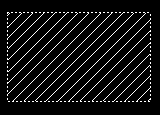
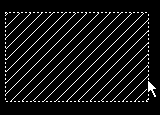
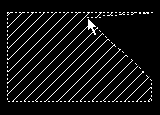
1 . The defined polygon shape is rectangular. 2 . Click a polygon side to add a new point. 3 . Drag the point in any direction to change the shape of the polygon. To delete hatches or fills, Hatch Erase and Hatch Erase All can be used to delete hatches that are on comment layers . With the selection filter set to ' Hatches ', you can select a hatch and press the Delete key. For hatches added using Hatch Add Define Polygon , deleting the hatch always deletes the defined polygon.
To edit hatches or fills or defined polygons, HatchEdit and Hatch Edit All can be used to open the Hatch Edit window. That window will be read-only if the hatch is on a non-comment layer. Other methods such as double-click or select then right-click and choosing " Edit " can also be used to edit or review hatches. The defined polygons added using Hatch Add Define Polygon are actually polygon sides , which can be edited on the Polygon Side Edit window to, for example, adjust their line type (dash pattern) or pen number (plotted stroke weight).
Display Options: " Hatches/Fills "
Also see: Automatic detailing can generate hatch patterns. These are not the same as the user-added hatch patterns discussed here. Polygons > Hatching Erase and Polygons > Hatching Explode do not operate on user-added hatches. They only operate on hatches that were generated by auto detailing.
page 1 | contents | topics | graphics, objects & decorations | top
Holes can be added or edited on non-comment layers only when your current Drawing Editor drawing is a crane placement drawing . On all other drawings, adding and editing of graphic objects is limited to comment layers. These instructions assume that your current drawing is not a crane placement drawing.
|
User-added and auto-detailed holes can be modified using the same tools. |
User-added versus auto-detailed holes: User-added holes are holes added using Hole Add in the Drawing Editor . Auto-detailed holes are generated (in a full-featured SDS2 program , not in Site Planning) during auto detailing of members or submaterials or erection views.
Tools for user-added and auto-detailed holes: The display of '' Holes " can be turned on/off on the Display Options window. Hole settings are shown on the Hole Edit window or on the " Holes " tab of the Multi Items Edit window. Holes are filled using the " Filled hole pen color " in Drawing Presentation ( Fabricator Setup ).
Tools for user-added holes on comment layers: Delete , Hole Mode , Hole Add , Edit Hole , Hole Erase and Hole Erase All are all able to operate on comment layers . You can edit multiple holes and " Save " and " Load " archived files of hole settings if the holes are on comment layers. You can move holes by dragging them in Select Items mode, or by using Move/Stretch . You can Explode holes on comment layers into component lines.
Tools for auto-detailed holes: To review the 3D settings (from the 3D model) of an auto-detailed hole, you can use Review 2D Items , or you can double-click the hole with the selection filter set to ' Polygons ' -- either method will open a non-editable version of Modeling's Hole Edit window.
Please note: Holes added using Add Hole do not appear in the 3D model and cannot be CNC downloaded.
page 1 | contents | topics | graphics, objects & decorations | top
Hole symbols can be added or edited on non-comment layers only when your current Drawing Editor drawing is a crane placement drawing . On all other drawings, adding and editing of graphic objects is limited to comment layers. These instructions assume that your current drawing is not a crane placement drawing.
|
Hole symbol tools: Hole Sym Add , can add a hole symbol to a comment layer , but not to a non-comment layer. Hole Sym Combo can add a hole symbol with a leader line and pointer to a comment layer. Material Callout reads a hole that you locate and lets you create an optional pointer to a hole symbol that summarizes the hole's properties. Hole Sym Edit can review hole symbols on non-comment layers, or edit hole symbols on comment layers. Hole Sym Erase can delete selected hole symbols that are on comment layers. Erase All deletes all hole symbols that are on shown comment layers.
Also: Hole symbol settings are on the Hole Symbol Input window. You can drag a hole/slot symbol in Select Items mode. You can use Copy Objects to copy a hole symbol. A hole symbol has one exact point . The symbol has a " Symbol location " option which controls its side (' Left " or " Right " or " Top " or " Bottom ") with respect to its exact point.
Text setup: " Labels character height " and " Labels width/height ratio " in Drawing Presentation apply as defaults for the first hole symbol added during a Drawing Editor session. Each subsequently added hole symbol uses the settings of the most recently added hole symbol.
page 1 | contents | topics | graphics, objects & decorations | top
Images are GIF, PANG, JPEG or TIFF files. They can be printed, or they can be used as temporary templates for tracing or orientation. To more accurately visualize how an image will look when printed, set your " Drawing Editor background color " to white. Like other Drawing Editor objects, images can be added or edited on non-comment layers only when your current Drawing Editor drawing is a crane placement drawing . On all other drawings, adding and editing of graphic objects is limited to comment layers. These instructions assume that your current drawing is not a crane placement drawing.
|
Format (.eat) Applications Descriptions GIF (.gif) logos, line drawings, icons, SDS2 screen shots GIF and PNG are similar, compressed formats. PNG is newer. Both allow transparency. PNG (.png) JPEG (.jpg, .jpeg) photographs The JPEG format can be used for photorealistic images. TIFF (.tif, .tiff) logos, line drawings A TIFF image converted into a GIF or PNG takes up less space. Image tools: Image Add can add an image to a comment layer , but not to a non-comment layer. Image Edit can review images on non-comment layers, or edit images on comment layers. Image Edit All can be used to edit all images that are on shown comment layers. Image Erase can delete selected images that are on comment layers. Image Erase All deletes all images that are on shown comment layers.
Also: Image settings are shown on the Edit Image window. To move an image, grab its center and drag it in Select Items mode. To re-size an image, grab its edge and drag it. " Keep display ratio " on the Edit Label window maintains the image's proportions when you re-size it.
Display Options: " Images "
Images are embedded: Images added into a drawing are copies of the original image and are embedded in that drawing. If you delete or alter the original drawing file, the copied image will remain unaltered.
page 1 | contents | topics | graphics, objects & decorations | top
Labels are a type of text. Labels can be added or edited on non-comment layers only when your current Drawing Editor drawing is a crane placement drawing . On all other drawings, adding and editing of graphic objects is limited to comment layers. These instructions assume that your current drawing is not a crane placement drawing. Also see special labels .
|
|
|||
| The color green is applied to the labels in the above example. Labels should not be confused with the text that is a part of bevel symbols , dimensions or weld symbols . |

an empty label (a space character)
Empty labels, which are labels made up of only space or carriage-return characters, have their perimeter boundaries marked with dots to make it easier for you to find them and delete them.
Label tools: Label Add can add a label to a comment layer , but not to a non-comment layer. Label Combo can add a label-pointer combo to a comment layer. Label Edit can review labels on non-comment layers, or edit labels on comment layers. Labels Edit All can be used to edit all labels that are on shown comment layers. Label Erase can delete selected labels that are on comment layers. Label Erase All deletes all labels that are on shown comment layers.
Also: Label specs are defined on the Label Edit window. To move a label, drag it in Select Items mode. The ' Labels ' selection filter applies to labels. The " Labels " option on the Display Options window can be used to turn on/off the display of labels. You can edit multiple labels and " Save " and " Load " archived files of label settings. To edit all labels with the same text, you can right-click while hovering any label with that same text, then choose " Edit Other " or " Select Other " on the context menu .
Note 1: The text that is a part of bevel symbols , dimensions and weld symbols are not labels. In other words they cannot be edited, added or erased using label tools. You can change them only by using bevel symbol, dimension or weld symbol tools.
Note 2: The text of piecemarks , section sizes , camber annotations and elevation offsets on 2D erection views are not labels.
page 1 | contents | topics | graphics, objects & decorations | top
Labels, special. These are labels that can be placed using Label Add . They instruct the program to substitute appropriate information in place of the label at an appropriate time -- for example, when a sheet is plotted or, in the case of the X{Value} label, when the user makes an appropriate entry to the symbol's edit window.
| $NAME | ||
| " Label text " | output label | explanation |
| $NAME | sheet_x | For $NAME on a sheet outline , when the outline is used for a sheet, the label shows the name of the sheet. |
| Substitution is made immediately. In pre-7.3xx versions of SDS2 programs, $NAME was only for sheet outlines, and the substitution was made during sheet autoloading. Now $NAME can be used on any drawing type, not just sheets or sheet outlines . | ||
| Special Labels for Plotting ( place on a sheet outline ) (string substitutions are made during plotting ) |
|||
| " Label text " | plot format | example | explanation |
| $TIME1 | hh:mm:ss | 14:12:05 | 24 hour time |
| $TIME2 | hh:mm:ss | 2:12:05 | 12 hour time |
| $DATE1 | dd mmm yyyy | 16 Jan 2004 | day month year |
| $DATE2 | mmm dd yyyy | Jan 16 2004 | month day year |
|
$DATE3
|
dd mm yy | 16 01 04 | day month year |
|
$DATE4
|
mm dd yy | 01 16 04 | month day year |
| $JOB | alpha-numeric | jobname | current Job |
| $FAB | alpha-numeric | fabname | current Fab |
| $USER | alpha-numeric | Joe | login name |
| $HOST | alpha-numeric | station_1 |
work station
printed from |
| $REV | alpha-numeric | 3 | current " Sheet revision " of a sheet |
|
page 1 | contents | topics | graphics, objects & decorations | top
| A lasso drawn clockwise. | 
|
A lasso drawn counterclockwise. |
To draw a lasso: Hold down the left mouse button in Lasso Mode and drag your mouse pointer (
) across the screen to create a shape. Items within the periphery of the area box are selected or deselected depending on whether you have no key pressed ( Select ) or the Shift key pressed ( Select + ) or the Ctrl key pressed ( Select- ) or the Shift+Ctrl keys pressed ( Toggle ).
Selecting with a lasso versus an area box: Unlike selecting by area box, selecting by lasso lets you draw a lasso of any shape to select objects.
Direction matters: If User and Site Options > General > " Point selection by area box " is set to ' Directional ', then the direction you draw the lasso (clockwise versus counterclockwise) controls whether or not the entirety of an object needs to be inside the lasso for it to be selected.
An lasso can select or deselect: A lasso drawn using Select or Select + selects items. A lasso drawn using Select- deselects items that are already selected. A lasso drawn using Toggle inverts the selection state of items so that previously selected items are deselected and previously deselected items are selected.
Selectivity varies: A lasso can be used to select multiple lines, circles, end points or labels as a group. Set one or multiple selection filters to limit the type of objects you want to select within the area box (lines and/or circles and/or labels, etc.).
Also see: Area box
page 1 | contents | graphics, objects & decorations | top
Lines are straight lines. Polygon sides are not lines. LInes can be added or edited on non-comment layers only when your current Drawing Editor drawing is a crane placement drawing . On all other drawings, adding and editing of graphic objects is limited to comment layers. These instructions assume that your current drawing is not a crane placement drawing.
|
|||
| The color green is used for the lines in this detail. Other objects which look like lines, but are not, are dimension lines and construction lines and polygon sides (material lines). |
Line tools: Line Add can add lines to a comment layer , but not to a non-comment layer. Line Edit can review lines on non-comment layers, or edit lines on comment layers. Line Edit All can be used to edit all lines that are on shown comment layers. Line Erase can delete selected lines that are on comment layers. Line Erase All deletes all lines that are on shown comment layers. Shield erases a segment of a line. Trim (
) lets you cut a line segment at its point of intersection with another line. Extend (
) lets you extend one or more lines to another line. Line Extend to Intersection (
) can extend two non-parallel line segments that do not intersect to their point of intersection.
Also: To move a line in Select Items mode, grab its middle; to stretch the line, grab its end. The Edit Palette lets you set the color and line type for Line Add . The " Lines " option on the Display Options window lets you turn on/off the display of lines. " Break material lines at label interference " affects how lines are drawn across labels. A line has two exact points . BSRL acts on lines and polygon sides. You can edit multiple lines and " Save " and " Load " archived files of line settings.
page 1 | contents | topics | graphics, objects & decorations | top
Markers for broken symbol links :

a symbol (named weld)

marker (after the symbol is deleted)
When a symbol is deleted in a full-featured SDS2 program using the Delete Project Items utility, a broken link to that symbol remains in each drawing in which the symbol was originally placed. This broken link is graphically represented with a visual marker, which is a close-dotted rendering of its file name. The marker is printed.
If you create a new symbol (job symbol) with that same name (using Save as Symbol or the " New ... " button or Global Symbols: Copy to Job ), the new symbol will replace all markers in all drawings that were affected when you originally deleted the file. So long as the new symbol file is an exact copy of the original, those drawings will look exactly as they did prior to when the symbol file was removed.
You may wish to delete a marker to ensure that it never relinks. To delete the marker, start up the Drawing Editor , open a drawing in which the symbol is placed, then Symbol Erase All . If more than one symbol exists in the drawing and you want to erase only the one symbol, choose Symbol Erase .
page 1 | contents | topics | graphics, objects & decorations | top
Members are member lines and their associated marks. These items only appear on erection views.
|
|
The color green is applied to members on this erection view. |
Member tools (any mode): On the Display Options window, " Show hidden drawing members " can be used to display members that were hidden using Delete . Also on the Display Options window, " Member polygons " lets you hide 3D member polygons of members in an erection view. Mid Point can find the midpoint of a member on an erection view. BSMB can be used to base a construction line off of a member line.
Member tools ( Select Items mode): Double-click on a member to change its visibility or to hide/show its piecemark, section size, elevation, or etc. To move section sizes, piecemarks, etc., drag it using the left mouse button ( Select ). The Delete tool can be used to hide (not delete) members.
page 1 | contents | topics | graphics, objects & decorations | top
Pointers are straight or curved arrows. Pointers can be added or edited on non-comment layers only when your current Drawing Editor drawing is a crane placement drawing . On all other drawings, adding and editing of graphic objects is limited to comment layers. These instructions assume that your current drawing is not a crane placement drawing.
|
|||
| A pointer and a label . |
Pointer tools: Pointer Add can add a pointer to a comment layer , but not to a non-comment layer. Pointer Edit can review pointers on non-comment layers, or edit pointers on comment layers. Pointer Edit All can be used to edit all pointers that are on shown comment layers. Pointer Erase can delete selected pointers that are on comment layers. Pointer Erase All deletes all pointers that are on shown comment layers.
Also: You can add pointers to comment layers using Weld Combo or Label Combo . To move a pointer on a comment layer in Select Items mode, grab its middle; to stretch the pointer, grab its end. Shift -drag the middle of a pointer in Select Items mode to change its " Pointer curve " to ' Straight ' or ' Clockwise ' or ' Counter-clockwise '. The Edit Palette lets you set the color for Pointer Add . The " Pointers " option on the Display Options window can be used to turn on/off the display of pointers.
Defaults for Pointer Add : The line type (dash pattern) for a pointer is always Type# 1 (a continuous, non-dashed line). The last-added or last-edited pointer sets the " Pointer curve " and " Face indicator " and " Pen color " for pointers laid out using Pointer Add . The default display color (pen number) for Pointer Add can be also be set using the Edit Palette .
page 1 | contents | topics | graphics, objects & decorations | top
Polygons are materials generated during auto detailing in a full-featured SDS2 program . Polygons cannot be generated in Site Planning.
|
|||
| The color green is used for polygons in this example. |
Selecting polygons: To select material polygons, the selection filter must be set to ' Polygons ' or ' All '.
Site Planning can only operate on polygons that are on comment layers: You may find hatching on a comment layer due to it having been placed there using Add Standard Detail or Paste . Most polygons that you see on drawings will be on non-comment layers, and you cannot move, delete or edit such polygons in Site Planning.
Moving/stretching polygons: Use Move/Stretch . To move a polygon, you need to select the entire polygon. To stretch a polygon, you need to select end points or move the polygon side .
Other tools for polygons: Double-click a material in Select Items mode with the selection filter set to ' All ' or ' Polygons ' to review the material's 3D settings from Modeling (see Review 2D Items ). The Delete tool erases polygons. Cut and Copy can be used on polygons, and they will remain polygons when you Paste them (exception: see polygon sides ). Hatching Erase removes the hatch lines (/ / /) that are associated with certain material polygons; Hatching Explode turns the hatch lines (/ / /) into lines.
page 1 | contents | topics | graphics, objects & decorations | top
Polygon sides are the edges of material polygons . In other words, material lines.
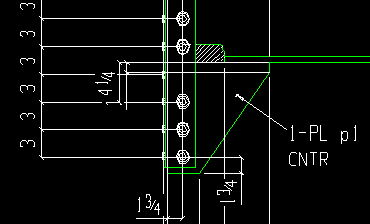
The color green is used for polygon sides in this example. Polygon sides are material lines. Polygon side tools: Double-click a polygon side to open the Polygon Side Edit window. BSRL acts on both polygon sides and lines. Mid Point can find the midpoint of a polygon side. The Delete tool can erase polygon sides and does not change the affected polygon to lines. Cut and Copy can be used on polygon sides, but the polygon sides are converted into lines when you Paste them. When you Move/Stretch a polygon side, the material polygon associated with that side is stretched. Operations such as Copy Objects and Copy & Paste convert the copies of the polygon sides into lines unless all sides of the complete polygon are copied.
page 1 | contents | topics | graphics, objects & decorations | top
Reference drawings can be created using Drawing Conversion to convert a copy of a .dxf, .dxb, .dwg or .dgn file. You can also create a reference drawing using the " New... " button.
|
|
||
| A reference drawing may look like any other Drawing Editor drawing. This reference drawing is a simple set of grid markers. Green crosses are drawn at intersections to provide locatable INRL points. |
Primary application: You can add a reference drawing that has been converted from a program such as AutoCAD as a reference drawing in Modeling , where it can serve to provide locatable points (using REFD ) for the layout of construction lines, or as a check to confirm that the model layout matches the original drawing. Of course, you may also want to create reference drawings inside of Site Planning using the " New... " button, but this may not be necessary since you can, instead, import a native Drawing Editor drawing type such as a detail , job standard detail or 2D erection view as a reference drawing into Modeling .
Reference drawings created in Site Planning can be renamed using Home > Utilities > Utility Functions > Rename Project Items .
page 1 | contents | topics | graphics, objects & decorations | top
A revision chart tracks revisions made to sheets. Tools updating a revision chart are available in a full-featured SDS2 program , but not in Site Planning.
|
In the above example: White lettering was automatically entered to this revision chart during automatic detailing of members on the sheet in a full-featured SDS2 program . Cyan lettering was entered manually in SDS2. "0" "1" and "2" in the "REV" column are sheet revisions. The dates in the "DATE" column tell you when the sheet was incremented. "21" and "18" are the member numbers of members on the sheet that were revised (re-detailed) during a particular sheet revision. "CO-1" "CO-3" and "CO-4" are whatever " Short revision description " was set when the detail was updated on the sheet during Detail Members in a full-featured SDS2 program.
Setup: Home > Project Settings > Fabricator > Sheets and Reports > Sheet Revisions sets the column headers and the widths of the columns that appear on that revision chart ("REV" "DATE" etc. in this example).
page 1 | contents | topics | graphics, objects & decorations | top
Section arrows indicate that a cross-sectional drawing has been made of the area pointed to.
|
page 1 | contents | topics | graphics, objects & decorations | top
Sheet items are editable or non-editable in Site Planning.
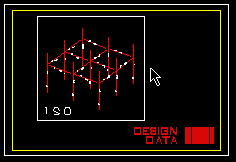
|
This erection sheet has one sheet item -- the 2D erection view named "ISO." |
Editable sheet items are details or submaterial details or erection views or job standard details that have been placed onto a comment layer on an erection sheet . In Site Planning, you are limited to placing erection views or job standard details as sheet items. If you double-click an editable sheet item, an editable version of the Edit Sheet Item window opens. Tools for editable sheet items include Add , Edit , Erase , Erase All and Erase From All .
Non-editable sheet items are details or submaterial details or erection views or job standard details that have been placed on non-comment layers. Sheet items can be added to a non-comment layer on an erection sheet in a full-featured SDS2 program .
page 1 | contents | topics | graphics, objects & decorations | top
Sheet lines can be placed on a sheet outline to identify those areas on the sheet you do not want to place graphic objects onto. For example, you can use them to identify the locations of logos and title blocks that are already printed on a preprinted sheet.
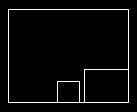
|
In this sheet outline, the white lines are sheet lines. Even the sheet edges, which are generated automatically, are sheet lines. |
Special characteristics: Sheet lines do not plot. Sheet lines do not generate points for Locate options such as INCL or VTPT or etc.
Tools for sheet lines: Sheet Line Add (to place sheet lines on a sheet outline). Sheet Line Erase (to delete sheet lines). Sheet Line Erase All (to delete sheet lines)
page 1 | contents | topics | graphics, objects & decorations | top
A shorten limit line is a light blue (cyan) line that appears to the right of the main view on a member detail .
|
Not printed: Shorten limit lines only appear on screen. They are not Plotted .
Purpose: Auto detailing routines in a full-featured SDS2 program place cross sectional views to the right of the shorten limit line on member details. Since there are no shortening or unshortening tools in Site Planning, a shorten limit line has no useful purpose in an SDS2 review program.
page 1 | contents | topics | graphics, objects & decorations | top
Symbols and global symbols are user-configurable graphics with editable "values" that are defined using special labels . The special labels in these examples are ${face} and ${Quantity} . The special labels in these examples are ${face} and ${Quantity} . The "values" in these examples are the letter A (face) and the number 6 (Quantity). Like sheet items , symbols are linked graphics. Adding a symbol does not create an embedded copy of that symbol -- see the warning below.
|
drawing before
Save as Symbol |
value entered | symbol as added |

|
|

|

|
|

|
Symbols (job symbols) are stored in your current Job , which means that when you Transfer a project to a different user, the symbols will be included. You can Open a symbol by first selecting '
Symbols ' on the selection dialog. Symbols can be created from drawings such as standard details using Save as Symbol , or from global symbols by using the Global Symbols: Copy to Job utility, or by pressing the " New ... " button on the selection dialog for Open when '
Symbols ' is selected as the drawing type.
Global symbols are maintained in the data directory for your current version of Site Planning. Inside the Drawing Editor , you can Open a global symbol by first selecting '
Global Symbols ' on the selection dialog. However, you cannot Symbol Add and select a global symbol to add it to a drawing. You need to first use the Global Symbols: Copy to Job utility to copy that global symbol, then you can Symbol Add to add the copy of the global symbol.
Utilities for copying and converting: The Job Symbols: Copy to Global utility copies symbols that you select from your current Job into a global symbols repository that can be accessed by any Job which shares the data directory that is used by your current version of Site Planning. The Global Symbols: Copy to Job utility copies symbols that you select from the global symbols repository into your current Job, where they can be added to drawings using Symbol Add . Symbols that you create in Site Planning can be renamed using Home > Utilities > Utility Functions > Rename Project Items .
Symbol tools: Symbols can be placed onto drawings using Symbol Add . During an Symbol Add operation, a preview image is shown, and may be adjusted on the Symbol Add window, before the symbol is placed. Double-click a symbol to open its X Edit window ( X = " Symbol name ") and change the "value" that was configured using a special label . You can also change a symbol's " Rotation " on its X Edit window. Symbol Edit All , Erase and Erase All tools are also available for symbols. You can Explode a symbol, thus breaking its link to the original symbol file and creating embedded copies of its individual graphic elements (lines, circles, labels, etc.). Copy Objects can be used to copy a symbol. " Symbols " in Display Options can be used to turn on/off the display of symbols.
The insertion point: Verify Reference Point can be used to verify and change a symbol's insertion point. This applies to symbols whose files you Open , and it also applies to whatever drawing type you are in before you do a Save as Symbol . Once a symbol has been placed, its insertion point is an exact point .
Once a symbol has been saved, it is available for use in your current version of this program. You can add the symbol (using Symbol Add ) to a comment layer in any drawing in any Job that is also in that version.
Symbols are more than just linked graphices. They also exhibit behaviors that are consistent with embedded graphics. When a symbol is placed into a drawing, the user can, for example, type in label text to be applied to the symbol -- that user-added information is stored in the drawing to which the symbol is added.
VIDEO 
Watch this video closely when the reference point is changed in the original symbol file. The placed symbol changes positions on the drawing, as would be expected with a linked graphic. On the other hand, the edit window of the symbol is not updated with the changes to the original file -- a behavior that is consistent with an embedded graphic. A placed symbol is a hybrid of a linked graphic and an embedded graphic. (Recorded in SDS2 Detailing , v7.3.) Warning 1: If you add a new symbol (e.g., a circle) that overwrites an old symbol file (e.g., a square), you will cause all symbols that have been placed in drawings using that old file to be redrawn per the new file (e.g., square symbols will become circles in all drawings in which the original symbol was placed).
Warning 2 : If, in your current Job , you File > Verify Reference Point to change the insertion point of a symbol that has been placed into drawings in that Job, that symbol's reference point location will remain the same in those drawings, but the symbol itself will shift its location with respect to that reference point. To be precise, the symbol's location in all of those drawings will shift the exact scaled distance (but the opposite direction) that you moved the reference point.
page 1 | contents | topics | graphics, objects & decorations | top
Tables can be can be found on any Drawing Editor drawing.
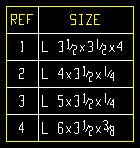
|
Tables can be made up of any number of columns and rows. Each corner of a table is an exact point . |
Tools: You can double-click a table to review its settings. Settings for tables can be found on the Table Edit window. You can turn on/off the display of " Tables " in Display Options . Look for Table Add , Table Edit , Table Edit All , Table Erase and Table Erase All tools in the command group named ' Objects -- Tables '.
page 1 | contents | topics | graphics, objects & decorations | top
Viewports are dashed lines around a sheet item or a section of a sheet item. " Viewports " must be displayed ( ![]() ) in order for you to see this dashed line. The viewport masks the area of a sheet item that is outside its border, while displaying the area that is within its border. Only one viewport can be active at a time.
) in order for you to see this dashed line. The viewport masks the area of a sheet item that is outside its border, while displaying the area that is within its border. Only one viewport can be active at a time.
|
In Site Planning, viewports are fully adjustable on sheet items that were placed onto a sheet in Site Planning.
Extents, user-named and custom viewports: A sheet item can have multiple viewports, but only one viewport can be selected at a time (using " Viewport " on the Edit Sheet Item window). An extents viewport is the default viewport. A user-named viewport is placed -- and its clipping limits are initially defined -- using Viewport Add on the original drawing that the sheet item links to. Other tools for user-named viewports are Viewport Edit (to change the user-named viewport's name) and Viewport Erase (to delete the user-named viewport). A user-named viewport can be selected in Select Items mode on the original drawing with the ' Default ' or ' All ' or ' Viewports ' selection filters by drawing the area box from right to left . A custom viewport is created when you adjust an extents or user-named viewport (re-size or reshape it) on the sheet item.
Applications : Two copies of the same drawing can have different viewports. The viewport for one copy of the original drawing might show, for example, the left half of the original drawing, while the viewport for the other copy might show the right half.
Only one viewport can be active on a sheet item at a time: You select the one you want using " Viewport " on the Edit Sheet Item window. Selecting ' Extents ' causes the entire drawing to be shown.
A custom viewport is created when you adjust an extents or user-named viewport: " Viewports " must be displayed (
) in order for you re-size or reshape them. To re-size a viewport , you can drag its end points. To re-shape a viewport , drag its border. You can Undo as needed. If the original viewport was an extents or user-named viewport, a new custom viewport will be created. User-named viewports can only be re-sized or re-shaped on the original drawing. The size and shape of extents viewports are automatically set to match the extents of the sheet item.
page 1 | contents | topics | graphics, objects & decorations | top
Weld symbols specify how materials are to be welded together. Weld symbols can be added or edited on non-comment layers only when your current Drawing Editor drawing is a crane placement drawing . On all other drawings, adding and editing of graphic objects is limited to comment layers. These instructions assume that your current drawing is not a crane placement drawing.
|
Weld tools: Weld Symbol Add can add a weld symbol to a comment layer , but not to a non-comment layer. Weld Combo adds combined pointers, leader lines and weld symbols to a comment layer. Weld Symbol Edit can review weld symbols on non-comment layers, or edit weld symbols on comment layers. Weld Symbol Erase can delete selected weld symbols that are on comment layers. Weld Symbol Erase All deletes all weld symbols that are on shown comment layers.
Also: Weld settings are shown on the Weld Edit window. The option " Welds " on the Display Options window lets you turn on/off the display of welds. Moving a weld symbol in Select Items mode also stretches an attached pointer or attached line unless you hold down the Shift key before grabbing the weld symbol.
Printing: The drawing pen number applied (in a full-featured SDS2 program) during automatic detailing of weld symbols is set in Drawing Presentation using the option " Weld pen color ." During printing, the weld symbol's pen number sets the plotted line thickness of the weld symbol. If you are using the ' SDS2 ' font for weld symbols, then the drawing pen number also sets the stoke weight of the weld's text. Line Weights sets the plotted line thickness and line color that will be applied to graphic objects printed with a particular drawing pen.
Fabricator Setup: Drawing Presentation > Sizes > " Weld symbols character height ."
page 1 | contents | topics | graphics, objects & decorations | top
Workpoints ( o ) and their origin symbols ( ![]() ). A workpoint is the point that extension dimensions are measured from. A workpoint origin symbol identifies the position of a workpoint. Workpoints and their origin symbols can be found on member details and submaterial details that have been auto detailed in a full-featured SDS2 program . Other drawing types may also have workpoints -- if they have been placed there using Workpoint Add . On drawings that do not have a workpoint, extension dimensions are measured from the drawing's 0, 0 coordinate (see X, Y Z display ) or, for standard details, from the standard detail reference point .
). A workpoint is the point that extension dimensions are measured from. A workpoint origin symbol identifies the position of a workpoint. Workpoints and their origin symbols can be found on member details and submaterial details that have been auto detailed in a full-featured SDS2 program . Other drawing types may also have workpoints -- if they have been placed there using Workpoint Add . On drawings that do not have a workpoint, extension dimensions are measured from the drawing's 0, 0 coordinate (see X, Y Z display ) or, for standard details, from the standard detail reference point .
|
An origin symbol on the detail of a beam. | |||
|
When the origin symbol is selected, the end point that identifies the actual workpoint is also selected. Move/Stretch can be used to relocate a workpoint and its origin symbol. |
Tools for workpoints and origin symbols:
Workpoint Add can be used to place a workpoint. Settings such as a workpoint's " Rotation " are specified on the Workpoint Edit window. You can Edit ( double-click ) or Edit All to access these workpoint settings.
Each workpoint in a drawing has a unique number (" Workpoint ID ") assigned to it. The " Workpoint ID " on the Edit Dimension window lets you assign the extension dimensions being edited to a particular workpoint.
You can select or double-click an origin symbol and its workpoint ( end point ) when the ' Default ' or ' All ' selection filters are active.
Using Move/Stretch to drag the extension dimension workpoint and the origin symbol causes extension dimensions to be automatically recalculated. This can be done on any type of drawing.
For Add Extension Dimension operations in a drawing that has more than one workpoint, you are prompted to select the one workpoint that you want to dimension from.
page 1 | contents | topics | graphics, objects & decorations | top
